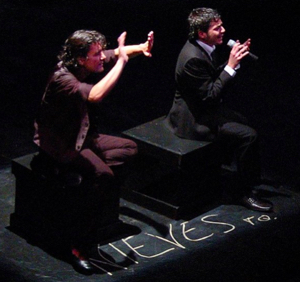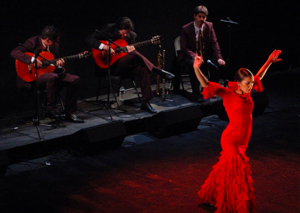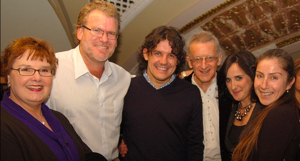Blog: José Barrios & Company
November 24, 2010 by Ken McNaughton

Figure 1. José Barrios (left) signs and Juan Debel sings for Nieves.
Michael, thanks for your great review of the José Barrios performance at the Gala Theatre on Thursday. I attended on Friday and ran into my friend Paula Durbin, who publishes dance reviews in The Washington Post. She said these flamenco performances really need a musical review, so I sent her yours.
The Fundación Conservatorio Flamenco Casa Patas of Madrid incubates nouveau flamenco and we are the benefactors when, once a year, the Teatro Hispano Gala—under the guidance of managing director Rebecca Read Medrano and her colleagues—brings us a special troupe. The performance this year by José Barrios and Company was truly a complete experience. The first standout on Friday was when the young cantaor, Juan Debel, stepped up for Noche Callada/Quiet Night. He approached two wooden cubes, where the male dancer, José Barrios, had chalked on the pavement, Nieves. Juan’s cante jondo was haunting. He fully occupied the song, which he also wrote. He became the music. José signed the words, and it turns out that the song was dedicated to Nieves, a deaf friend who passed away.
Diego Villegas is the only performer who has been part of the visiting troupe three years in a row. How would we manage without him? He is still only 23. Like Peter Pan, he doesn’t seem to age. Not only does he play saxophone, flute and harmonica, he plays them beautifully. He plays them jazz. He plays them flamenco. And he takes enormous leaps that leave one breathless. He fuses them. So it was an enormous pleasure to find that the lead female dancer is his sister, Raquel Villegas. Raquel stepped forward in a stunning red dress for her Soleá—Tu Luna/Your Moon. It’s not easy to come up with new flamenco dance moves, but Raquel kept us off balance with unusual twists and turns.
About half way through the performance, which had no intermission, I was thinking to myself, “It would be nice if they included some tunes with which I am familiar.” The Gipsy Kings usually include one Anglo cover with each CD. Shortly after, I am listening to Diego’s soaring solo and I can hardly believe my ears. Why does this sound like Killing Me Softly (with his guitar), a song made famous by Roberta Flack in 1973? Surely Diego is not sampling Killing Me Softly? But he is. There is a link to flamenco with the “guitar,” even if “killing me softly” is maddeningly ambiguous. A little later we hear strains of My Way, the fiercely independent Sinatra refrain, which seems particularly poignant coming from Diego.

Figure 2. Raquel Villegas dances her soleá.
At this time I have to tell you a brief anecdote. One night about nine years ago I went to Catalán West, on F Street with my best friend at the time, Jeffrey Deaver. Jeff wrote The Bone Collector, which was made into a movie starring Denzel Washington and Angelina Jolie, and he is currently writing the next James Bond book, due out on Ian Fleming’s birthday, 28 May 2011. Catalán West unfortunately closed a few years later, but on this night, there was a large group of flamencos at one table, including Natalia Monteleón, Torcuato Zamora on guitar, Sara Jerez and some other dancers. In a break the sound system moved into I Will Survive by Gloria Gaynor, and I could not restrain myself. I jumped up and asked Sara if she would dance. It was a ballsy move, busting in on a table of flamencos, especially since I was merely a creative freestyler with no professional training. Sara politely declined, saying she didn’t want to make an exhibition of herself. I was crushed, but not enough to stop me from asking one of the other girls, who agreed. So we proceeded to make an exhibition of ourselves and had a wonderful time. It was one of those incidents that endeared me to this group and helped make their friendship so rewarding.
Now, back to José Barrios at the Gala Theatre. We are approaching the end of the program. We have seen some wonderful dancing, heard some great guitar, and Diego has seduced us with his wild instrumentation, including sampling a couple of Anglo tunes. What will they do for a finale? No. It can’t be. It’s not possible. Are these goose bumps up and down my spine? It’s—I Will Survive!!! José has come fully alive, with his loud palmas, huge smile and fast footwork. The whole company joins in. We give a standing ovation, with shouts and whistles. We demand an encore and they satisfy us with the classic flamenco kiss-off, when roles are reversed. The cantaor David Vásquez, with his large mustache, gives us a great dance, as does Diego. This show has shape. And Juan Debel has shown us how to perform so completely that there is no barrier between him and the audience. We experience the song along with him.
During the performance I sat next to Rosemarie Ruíz Houghton, an opera singer who teaches voice at Catholic University. Behind me were Emily Mazzotti and her husband Chris Eagan. Emily teaches flamenco in Crystal City (https://emilymazzottids.wixsite.com/mysite). It was her enthusiastic jaleos that encouraged my signature piercing whistle for special moments. After the final bows we made our way to the basement to await the performers and sample the wonderful food and drinks at the reception. Taberna del Alabardero was one of the sponsors. Did they supply the food? I met the manager, Javier Velázquez, who is from Madrid, and talked with his nine-year-old daughter, María, who learns flamenco from Carmen de Vicente. When I asked María, who was born in Seville, if she and I had met at Feria in May, she asked “Seville or Washington?” José Barrios and guitarist Jesús Núñez will perform at the Taberna on November 26th and 27th.

Figure 3. (l-r) Rosemarie, Chris, José Barrios, Ken, Begoña and Emily.
We also met up with Edwin Aparicio, whose dance company will perform at the Gala on December 4th and 5th; Aleksey Kulikov; Hector, one of our local cantaors; and his colleague, Wilbur, who is learning guitar from Richard Marlow. Richard goes once a year to a guitar workshop with his teacher, Gerardo Núñez, in Sanlúcar de Barrameda, which is where Diego lives and where Raquel has a tablao called Bodegón A Contratiempo. Contratiempo is the term applied when one or more people clap palmas off the beat, with one or more people who are clapping on the beat, which gives the impression of double speed. This is particularly effective, and I only noticed it once in tonight’s performance.
There was plenty of time to eat, drink, take photos and mingle with the stars. I noticed what I noticed two years ago—these performers, many of whom don’t speak much English, seemed very comfortable and relaxed mixing with the audience, many of whom don’t speak much Spanish. The Fundación Conservatorio Flamenco Casa Patas grew out of a Madrid tablao, Casa Patas (House of Feet). Begoña Fernández is manager of the Fundación and it was a pleasure to meet up with her again. She engineered us into a photo with José.
NOTES
Photos are published by kind permission from EventosVipPass. This work is copyrighted and may not be reproduced in whole or in part in any medium without written permission from Ken McNaughton Living Trust, 3778 College Avenue, Ellicott City, MD 21043; phone/fax: 410-418-9340; kjmcn@comcast.net (24 November 2010).



